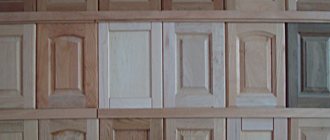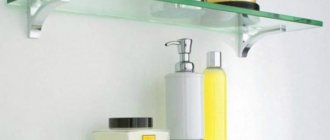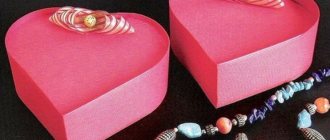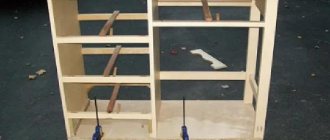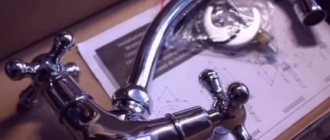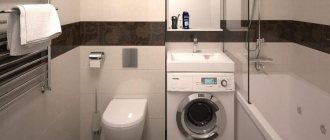What's good
The advantage of attaching the faucet to the side of the bathtub is that it is an unusual decorative solution and practical for daily use. It is also worth noting a number of other advantages:
- There is no need to drill into the wall near the bathroom, which is convenient when the bathroom is purchased and installed directly after repairing and finishing the walls of the room, when changing the stylistic direction.
- They hide communications and pipes under the bathtub if it is in the middle of the room.
- Accessibility during water procedures - no need to reach for a watering can or tap, such elements are easily accessible by hand.
- The original appearance of the bathroom is perhaps the main advantage. By placing the mixer in the center of the wide side of the bath, you decorate the interior of the room with unusual notes.
For mounting on the side of the bathtub, either a complete mixer with a shower or installation separately can be used. The shower head, faucet and control unit located separately on the same plane look original.
Choosing an installation location
Theoretically, any arrangement of the mixer parts is acceptable. However, during renovation, access to faucets near the wall will be difficult. To repair, you will need to dismantle the bathtub, turn it over, replace the components, then reinstall the bathtub and seal the joints.
The installation location is chosen so as not to impede access to the mixer during repairs.
Install the faucet either on an open edge, behind a removable screen, or against a side wall, but closer to the edge, to provide access to the faucet components. Most often, the shower hose fails (it is believed that it lasts no more than a year) - place it in such a place that replacement can be done without difficulty.
Some acrylic bathtubs are sold with ready-made holes - before purchasing, evaluate how convenient their location is.
Features of the design of a mortise mixer
Built-in bathroom faucets have an extensive list of advantages relative to their wall-mounted counterparts:
- strength and long service life due to the use of solid injection molded parts in the production process;
- quick collection of water without splashing on the walls;
- original lines and shapes combined with interesting modern design allow you to decorate the space with additional gloss;
- compactness – there is no need to create additional space in the bathroom during installation;
- static design, which does not allow the use of individual components, the installation does not break down;
- simple operation and use at home;
- solution to the problem of masking the connecting hose with a mixer or watering can.
Convenience also lies in the fact that the entire length of the hose from the shower head is usually hidden in camouflage frames from the bottom of the bathtub. Therefore, only the top part of the mixer without its connectors is visually visible.
The main and only drawback of the design is the wear and tear of the hose, which is constantly subject to mechanical stress.
Installation stages and features
For a professional plumber, installing a faucet on an acrylic bathtub is a matter of literally one or two hours.
But a novice master who decides to install the mixer himself may need much more time to complete all operations. Recommendations from experienced craftsmen on how to install a faucet in the bathroom will be a good help.
First, you should study the design of a bathroom faucet, since the installation of a popular single-lever faucet is somewhat different from the installation procedure of a traditional valve design. Before starting work, you should stock up on the necessary tools and materials:
- drill;
- milling attachment;
- screwdriver;
- adjustable wrench;
- flexible hoses;
- fasteners.
To install a mortise mixer, you must:
- Choose a suitable place and make markings on the side of the bathtub.
- Drill a hole of a suitable diameter using an electric drill equipped with an attachment with a core cutter.
- Place a special gasket under the mixer, which is supplied with the device.
- Insert the mixer into the hole.
- Secure the mixer under the rim. For single-lever structures, a special pin should be used, which is then secured with a steel half-washer. In addition, fastening nuts, one or more, are used.
- Firmly pull the mixer to the surface of the bathtub rim.
- Connect flexible hoses that will supply hot and cold water to the faucet. Special gaskets should be used for hose cap washers.
Manufacturers of mortise-type faucets often offer special mounting panels in addition to the main design.
The need for their use is motivated by the fact that when creating a hole in the side of the bathtub, its rigidity is violated, and the mounting panel or strip will strengthen the attachment point.
In practice, craftsmen most often do without this additional element. Often the mounting panel does not fit in dimensions and requires trimming. In addition, it is difficult to apply this element on the side of a rounded configuration. However, if there is any doubt that the bathtub will withstand the load with the reduced rigidity of the side, you should consult an experienced specialist on this issue.
The order of installation and installation - the main differences
Installing the structure on the side of the bathtub is basically no different from conventional mounting, but there are certain installation features.
For the most part, the differences in mounting depend on the type of faucet - single lever or with a shower head.
Single lever built-in spout without shower
The easiest installation option. The installation method consists of choosing a mounting location for the installation, cutting a hole on the side of the bathtub and attaching the faucet. As a rule, designs are used in which control is carried out by an adjustment lever from above. Therefore, a separate hole for fixing the control unit is not required.
Built-in faucet into the side of the bathtub - what tools are needed?
To install the structure you will need the following tools:
- Drill.
- Flexible hoses.
- Adjustable wrench.
- Milling.
- Fastenings.
- Screwdriver.
Cascade with shower
Mounting a cascade mixer does not require special skills. Installation and connection of the pipeline is carried out as in a conventional mixer, but with some differences. You will need several holes for the control unit, faucet and shower head. The only difference in control is the water supply: a cascade of water flows through an existing hole in the spout of the faucet, the appearance of which can be completely different.
Faucet selection
Before you begin installing the mixer, you must purchase it. Naturally, it must be of good quality and high quality.
So what characteristics should a good bathroom faucet have? First, you need to pay attention to the weight of the mixer. It should not be too light, since the durability of the plumbing depends on the thickness of the metal
Of course, heavy plumbing can also have a number of disadvantages.
Bathroom faucet diagram.
Bathroom faucets are usually made from two materials - silumin and brass. Silumin taps are much lighter than brass taps and have a lower price. However, this material, which is an alloy of silicon and aluminum, is very unreliable. With such faucets, troubles such as handles breaking off and clamping nuts breaking often occur. Silumin plumbing is short-lived, however, it is quite popular due to its low cost.
Brass faucets are much more expensive than silumin faucets, have greater weight and viscosity of the alloy. This alloy makes the clamping nuts and pipes more reliable; such a mixer will not break even under various mechanical influences. If your financial capabilities allow you to purchase more expensive plumbing fixtures, you should give preference to brass taps.
The technical characteristics of the mixer are also important, for example, its dimensions and model compliance with the installation location. A faucet designed to be built into the side of a bathroom is not suitable for installation on a wall and vice versa. Inspect the main parts of the faucet and determine whether they are suitable for your bathroom - the length of the shower hose, the faucet spout and the availability of accessories for mounting the shower head on the wall.
Selecting a location to drill 1 or more holes
If you plan to install only one top-control faucet, you will need to cut one hole on the side of the bathtub. Preliminary markings are made along the central part of the surface. If there is not enough space on the side, there are special side covers for mortise mixers. They will be required if the side of the bathroom is too narrow, almost flush with the diameter of the hole for the mixer.
If it is necessary to mount the unit (water supply tap, control unit and watering can), the most practical place for placing the accessories is selected.
The distance between the holes is not less than 11 cm, not more than 25 cm. The margin from the edge of the side on one and the other side is not less than 5 mm.
Is it possible to drill a hole in an acrylic bathtub at the edge from the corner?
The peculiarities of drilling an acrylic product consist in choosing the necessary tool that would not damage the base.
The material (acrylic) itself is soft, and therefore no special effort is required to insert the tap.
Sequence of actions:
- The drill is set to minimum speed - 300 rpm. Do not put pressure on the structure, otherwise it will burst.
- Mark the place for drilling with a sharp object so that the drill does not “lead” at the entrance; even a simple nail will do. Kernim without impact, screwing the nail into the acrylic.
- The drill is installed strictly vertically relative to the surface of the bath.
- Acrylic is a very soft and pliable material, so there is no need to cool the drill during work.
The watering can and spout are always attached side by side. If the control lever can be installed on the opposite side, then the gander and the watering can are nearby due to the fact that the watering hose is attached to the spout.
Drilling for mortise installation on enamel and other materials
The hole for the cut-in on the side of the bathtub is drilled in the place where it is most convenient.
For example, you don’t have to stand up to reach the tap if you install it in the center. And the watering can and shower hose can be attached in a corner so that they do not interfere with the usual collection of water. An ordinary drill copes with the task of drilling a hole in a metal or cast iron base. The only condition is to determine the correct degree of sharpening of the cutting tool. The optimal angle range is considered to be 116-117 degrees. The use of a drill with steel tips (more often - it will win) is also justified by the need to make holes in large volumes.
During the drilling process, pressure and force are not used, so the material can burst and deform not only at the thread, but also in the central part of the bead. When using a forstner drill bit on acrylic, you need to twist slightly from side to side.
The design of the drill necessarily corresponds to the metal processing.
Connecting communications and flexible hoses
After the holes are cut, they begin to attach flexible hoses and communications.
- There are three holes at the bottom of the mixer - for hot, cold and mixed water. First screw the hose into each hole. The largest one is the central one. Do not tighten the hoses while we are just planning.
- The faucet is placed at the top of the bathtub rim, and a plastic stand is attached below to further secure the faucet, firmly locking it in one position.
- The spout and shower head are attached alternately. In this case, the hose from the watering can is first threaded through the seat ring, since after fastening it will be impossible to install.
- Connect hot and cold water.
How to install a faucet on the side of a bathtub so it doesn't wobble
Attach the faucet to the side of the bath in the same way as to the wall. To prevent it from wobbling, use a plastic gasket on the bottom. Without this, it is impossible to tighten the faucet and install it tightly on the bathtub. Additionally, sealants are used to treat the lower parts of the seals.
Are mounting panels and strips required?
The use of mounting panels or strips on the side of the bathtub is advisable in situations where the quality and strength of the base of the product are not impressive. If there are doubts that fastening the mixer will negatively affect the operation of the structure, play it safe by choosing side covers. The faucet and watering can are subsequently attached to them.
Types of faucets on board
Bathtub mixers are divided into types according to the following criteria.
Material of manufacture
The most common material from which bathtub faucets are made is brass. The second most popular material is bronze, followed by stainless steel. Most models have a chrome-nickel coating, which makes it easier to care for the product and remove lime deposits. Antique-style faucets are made of polished brass or bronze, and various patterns and ornaments are applied on top of them. Over time, such taps darken and become covered with a patina, which adds additional charm.
Installation method and number of mounting holes
Depending on the installation method, onboard bathtub taps are divided into two types.
External
A device for external installation is essentially a regular faucet, additionally having a switch for the shower head. Depending on the design, installing such taps on the side or corner of the bathtub will require one or two mounting holes.
Mortise
The mortise mixer on the side of the bathtub is made in the form of separate elements that are installed in a separate hole. The concealed mixer consists of the following structural elements:
- Spout;
- Shower heads;
- Switch;
- One or two control knobs.
To install each element of a mortise-type device, you will need to drill a separate hole in the bathtub.
Depending on the design, to embed the product, you will need 3, 4 or 5 mounting holes:
- The 3-hole bathtub faucet includes a spout, a shower head and a common control lever.
- The device, mounted in 4 holes, is equipped with a spout, two control levers and a shower.
- This 5-piece product set includes a spout, a shower head, two control handles and a switch.
3-hole faucet.
4-hole faucet.
5 hole faucet.
The equipment for 3- and 4-hole devices may vary from manufacturer to manufacturer.
A distinctive feature of this type of faucets is that all connecting units, the mixing chamber and the shower hose are located behind the bathtub body.
All connection points are located at the bottom of the elements and are hidden behind the side.
Control method
Based on the method of controlling water flow, on-board devices are divided into several types.
Valve
The water pressure in such taps is adjusted using a faucet box, which comes in two types:
- Half-turn axleboxes have ceramic movable plates, which, when the handle is turned 90°, open or block the flow of water. The advantage of half-turn axle boxes is faster and more accurate adjustment.
- In their design, reversible axle boxes have a rod that extends when the handle is turned, at the end of which a rubber gasket is attached, which reliably closes the valve seat. To fully open the water flow, you need to make several turns of the valve handle. The advantage of valve axle boxes is their maintainability, while half-turn devices must be completely replaced if they break down.
Lever
Faucets with a lever control method allow you to simultaneously regulate the temperature and pressure of the water flow using one handle. The main element in such mixers is a cartridge or a metal ball. The advantages of cartridge locking devices include their low cost, the absence of additional seals and the ease of replacing a worn-out cartridge.
With built-in thermostat
By analogy with models for the sink, some manufacturers have begun to produce faucets with a thermostat for installation on the bathtub. Inside the case there is a special heat-sensitive cartridge that reacts to changes in the temperature of the water passing through it. Depending on the settings and temperature of the flow, hot or cold water is added to meet the specified parameters.
The advantages of equipment with thermostatic control include ease of use and safety for children, as well as significant water savings, since you do not need to adjust the temperature every time you turn on the tap. Disadvantages include the high cost of products and low maintainability, since spare parts are practically not produced.
Shower switch type
Bathtub rim mounted faucets use two types of shower diverter:
- Push-button or pull-out. Such a switch can be automatic or conventional. To redirect the flow of water to the watering can, you need to pull out the switch rod, and when you turn off the water in the automatic device, it will automatically switch to the spout. A simple switch differs from an automatic one only in that to switch back from shower to spout, you need to manually turn a little and press the switch flag.
Push-button shower switches are most often integrated into the faucet body. - A cartridge or rotary switch is a regular ceramic cartridge with a half-turn handle. The advantage of this type of switch is that it is easy to replace in case of failure. The cartridge switch is made only as a separate element.
Ceramic cartridges for switch from spout to shower
Spout shape and type
Spouts for onboard taps are made in various shapes, but always monolithic, without turning spouts. This makes the equipment more reliable and durable, since there are no additional connections of moving elements. Spouts are rectangular or tubular in shape.
Note! The main characteristic of the spout and mixer as a whole is the throughput of the equipment. The volume of water that can pass through the tap per unit of time depends on the diameter and shape of the hole, as well as the length of the gander.
Cascade
The most popular are faucets with a cascade spout, which, due to their shape, forms a wide stream of water reminiscent of a waterfall.
The shape of the cascade mixer spout is a metal plate with a narrow slot through which a wide flat stream of water flows. Often these spouts have decorative lighting to create the effect of colored water.
The advantages of the cascade include the originality of the solution, attractive appearance and increased spout capacity, while the disadvantages include a higher price.
Tips for a successful installation
Installing a mixer and shower head on the edge of the bathtub is a practical solution. The work does not require professional plumbing skills; you just need to choose the correct drill size and insert the device. But some tips are worth considering:
- The distance between two holes does not exceed 25 cm.
- It is better to choose a place for drilling on a wide part of the side.
- Do not drill into acrylic using force.
- It is advisable to install the gander or spout in the central part of the bath, and the shower hose in the corner.
- Calculate the diameter of the hole so that the side edges of the bathtub are against the wall if the installation is not in the center of the room.
- Additionally, silicone sealants are used to seal the exit from the hole from the inside. To do this, apply the composition to the inside of the seal.
Attaching the faucet to the side of the bathtub is a practical solution that allows you to enjoy the benefits of civilization without the slightest discomfort. In addition to impressive performance characteristics, this fixation method has visual advantages - the bathroom looks extravagant and original.
Step-by-step installation instructions
Follow this algorithm:
- Preparatory stage. After the installation location has been chosen, future holes are marked on the side of the bath. If the bathtub is made of acrylic, it is very convenient to make holes using a drill and a feather drill. In the case where the bathtub is covered with enamel, an additional metal plate, which covers the drilling site, will help to drill carefully. The distance between the holes should vary between 11-22 cm. The finished holes must be treated with sandpaper. This will make their edges smoother and neater.
- Installation of the shower hose is carried out through the hole of the largest diameter. Before installing the shower module, a pipe connecting the shower to the tap is inserted into the adjacent hole. The hose is inserted into the mounting hole and tightly fixed from the inside with a lock nut. To prevent leaks, o-rings are placed between the outer washer and the locknut.
- The final part. According to the manufacturer's diagram, all other parts of the structure are assembled. The corresponding pipes are connected to the central part, which is responsible for mixing cold and hot water. Also connected to the central part is a pipe responsible for supplying water to the spout. The watering can is fixed in the same way.
Why is this mixer better than others?
The advantages of all users who have installed such equipment in their bathrooms include:
- faster filling of the bath with water;
- no splashing;
- fashionable design;
- ease of use;
- disguising the shower hose under the side of the bathtub.
The disadvantages include the difficulty of replacing the shower hose and other faucet parts. This drawback can be mitigated by purchasing high-quality products produced by well-known brands in the plumbing market.
A cascade-type mixer with lighting will decorate the interior and allow you to enjoy a wide stream of water falling into the bathtub
Features of drilling through enamel
Remodelers believe that beginners should not make faucet holes in cast iron or steel bathtubs on their own. Unpleasant consequences can be caused by enamel, which is used not only as decoration, but also performs a protective function.
However, if the person who decided to install an enameled bathtub has experience in repair work, then you can try using special tools to insert the faucet.
In this case, in addition to the standard set of tools, you will need a special attachment for a drill, which is intended for cutting glass and ceramic products. The best option for such a drill is a ballerina attachment.
The advantage of the ballerina is that it has the shape of a compass, which can be adjusted to any diameter. Subsequently, this cutter can be used to install other products with a diameter different from the mixer holes.
To prevent the enamel from cracking when drilling, you need to do the work at reduced speeds. Some professionals recommend using a hand drill, which will not create as much vibration as an electric drill.
To prevent the nozzle from moving from the marking point, it is recommended to purchase a special jig - a bar (most often made of wood), which has cells inside in which the nozzle is attached.
For better contact of the nozzle with the enamel surface, it is recommended to place a container with water or a special coolant nearby. During the drilling process, you need to dip the nozzle into the liquid so that there is no burn in the hole for the mixing structure.
Some craftsmen act in a different way in order to avoid cracking of the enamel surface at the drilling site. A special metal plate is attached to the surface of the side, through which holes are drilled. After the foundation for the mixing system has been formed, the metal is removed and the structure is installed.
Installing a mixing system is not a difficult job. However, the process of cutting a mixer structure into the side of a bathtub requires knowledge of the basics of measuring holes, drilling and securing materials. Studying the basics of installation work, as well as preparing high-quality materials, will help you quickly and efficiently install a mixing system in an acrylic bathtub.
Installation and insertion
Well, now that all the preparatory work has been completed, let’s proceed to the insertion.
First, we need to “figure out” where our mixer will be located. To do this, you can use a tape measure, or outline what is said “by eye.” You need to understand that the standard hoses that connect the gander, the handle itself and the shower are about a meter long, and therefore it is advisable to place them side by side (if you need to stretch it to large sizes, for example, the gander is on one side of the bathtub, and the power handle and shower are on the other) you need to buy longer hoses! Think about this in advance). Personally, my distance is just 80 - 90 cm, so standard hoses are enough for me.
Also, I did the markings not using a tape measure, but by eye.
To begin with, I measure the “gander” itself.
After that the pen
And only then the shower connector.
The result is a kind of circle, you need to find the center in them.
The important thing is that you need to find the middle point. And after that, cut into the bathroom with a drill. I wrote above that the drill should be no more than 35 mm, why is this important! Because all mixers have a fastening of just 40 - 45 mm (sometimes more), if you take a drill with a large diameter, the mixer will simply fail! So don’t take risks, look for exactly 35 mm, all the fasteners and hoses from the mixer will actually fit into this hole.
Now we load the drill into the drill and drill the bathroom, it can be cut very easily with a FORSTNER drill, I used it to cut a stone sink , and acrylic is a couple of trifles.
The result was three holes, but to our marks. We will mount the mixer, handle and shower in them.
To begin with, I try everything on - everything is fine, nothing fails.
Disadvantages to be aware of
The disadvantage of such a mixer is that it has a very vulnerable hose for the shower head. Due to the fact that it is constantly rolled up, the material deforms over time - this leads to the appearance of cracks in the coating of the hose, through which water will splash in all directions while taking a shower.
It is easy to install a faucet on acrylic bathtubs, but when a cast iron bathtub is installed, the enamel may fly off, resulting in rust forming near the faucet.
Everything is the old fashioned way. Hole in cast iron bathtub!
The set of tools that will be required to make a hole in a cast iron bathtub will be the same as for an acrylic one. With the exception of a grinder, you will need it to remove the enamel.
You can make a hole in the bathtub yourself
The first stage, as in the previous section, is marking. Next, we will need to remove the enamel in the place where we will make the hole, since enamel is a fragile material, when drilling, chips and cracks form. For experienced craftsmen, it is permissible to drill without removing the enamel, but then it is necessary to constantly maintain the drilling angle. You should start drilling with a small drill, since you will not make a large hole right away, and then increase the diameter of the hole using large drills.
Remember that you are drilling metal, which means the drill will get very hot, you need to monitor this and give both yourself and the tool a rest when required. You should also use only well-sharpened drills, otherwise you doom yourself to drag out the process for a long time.
To summarize, I would like to say that making a hole in the bathroom is not so difficult; you don’t need to call a specialist for this - it doesn’t require any wild professionalism. You just need to follow the rules and be careful.
Features of installing cranes
The taps are installed on metal pipes, but sometimes it is necessary to install the faucet in the bathroom on polypropylene pipes or branch pipes. You need to use special fittings: water sockets or mounting strips.
For two-valve taps, mounting strips are used, since they immediately separate the connection to two taps. There is an important nuance: if the faucet is mounted high (more than half a meter), then the polypropylene supply pipes should be secured to the wall to avoid their vibration during water supply or pressure drop.
What to look for when buying a mortise mixer?
I would like to tell you the bitter truth right away - a good mixer cannot be cheap. Quality costs money, so be prepared to invest in equipment that is durable and can withstand heavy use. Saving is of no use here. Among other things:
- Choose a faucet based on the design of your bathroom. The equipment must be combined with the interior of the room, and also be convenient to use.
- The weight of a quality mixer is significant. Weightless products are made from a dubious alloy that is not able to cope with functional loads.
- Advanced models of mixing devices produce minimal noise even with a strong stream of water.
- The presence of a built-in temperature limiter in some faucets allows you to avoid skin burns.
- The temperature control function ensures the supply of water at a certain temperature. This is especially true for families with children.
And some modern models of mixers can reduce water consumption, which will have a positive effect on the amount for utilities in receipts sent monthly by management companies
Advantages
We are already accustomed to the fact that the mixer is attached to the wall. In small apartments, such a solution is appropriate, as it saves space and money. By installing the mixer at a sufficient height and having a long spout, you can easily use one device for both the washbasin and the adjacent bathtub.
Relatively recently, the wall-mounted device has a fairly strong competitor, which is mounted directly on the side of the bathtub. Such an installation has its undeniable advantages:
- Accurate and quick filling of the bathtub with water;
- Preventing droplets from splashing;
- Optimizing the space of the entire bathroom;
- Ease of use;
- Possibility of masking the shower head hose;
- Wide possibilities for decorating the interior of the bathroom.
As a result of installing a mixer on the side of an acrylic bathtub, the room becomes as comfortable, stylish and beautiful as possible.
Important! Cascade faucets, which imitate a small waterfall and can fill the bathtub in a few minutes, will add a special chic to the interior design of the bathroom.
Video material
If you want a modern and trendy bathroom, then the option of a mortise faucet in the bathtub will come in handy. Cascade cranes look especially charming. In any case, before installing a faucet into an acrylic bathtub, you should think carefully about everything, weigh all the advantages and disadvantages of the plumbing, the possibility of replacing several parts and the availability of repairs. If all the disadvantages of mortise plumbing seem insignificant to you, then go ahead and purchase all the necessary elements and proceed with installation, especially since you can do it yourself.



